 Image search results - "ako" Image search results - "ako" |

Three-day (Aug. 9-11, 2006) rowing route around the southern half of the lake by the Kyoto Univ. rowing club.1st day: Home base in Seta River to Manohama (crew change), then to Omi-Maiko.
2nd day: Omi-Maiko to Manohama, then to Chomeiji.
3rd day: Chomeiji to Manohama where crew changes. Then to home base in Seta River.
|
|

Three boats are used for the trip, sighted here off shore near JR Hira Station on the Kosei Line. 湖西線比良駅の沖
|
|
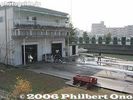
Seta Rowing Club's 2-story clubhouse located in Otsu, Shiga Prefecture. The club is a registered NPO. The club is named after Seta River at the southern tip of Lake Biwa. Regattas are also held on the river, Lake Biwa's sole outflowing river.
|
|

Lake Biwa is near the center of Honshu island between Nagoya and Kyoto.
|
|

One of two giant kitesThis festival has two giant kites and two smaller (but still large) kites. Resting on its side, the kite was scheduled to fly at 2 pm. The kanji characters read "Michi no Eki" in reference to a new train station built in the town.
|
|

Being my first regatta, I was at first daunted by the rowing terminology for the different types of boats.
|
|

Arriving Omi-Maiko on Day 1. Rowing around the lake has been an annual tradition.
|
|
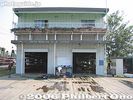
Seta Rowing Club's clubhouse. Boats are stored on the bottom floor, while the 2nd floor has office space, ergo machines, meeting room, locker room, etc. Web site here
|
|
|
|

Carrying back a single sculling boat
|
|
|
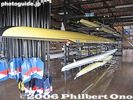
Oars and boats stored on the bottom floor. The club offers 2-hour rowing lessons on Sundays during May to Nov. Address: 6-1 Ogaya, Otsu, Shiga 520-2144 Japan. Phone/Fax: 077-545-9961, Email: info@setarc.jp
|
|
|
|

The place was not as crowded as you would think.
|
|

They use four-man boats (called "knuckle four" in Japanese) with sliding seats. It is stable and safe, ideal for beginners.
|
|
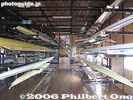
Many boats are made in Italy.
|
|

Lowering the kite
|
|

To mark the song's 100th anniversary, a new song monument was unveiled at Kyoto University (Yoshida-South Campus) on Nov. 25, 2017.
|
|

Rowing team from Nagahama
|
|

Each boat has four rowers and cox who steers the rudder.
|
|
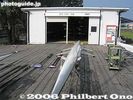
Right across the clubhouse is the Annex boat house.
|
|
|

Front side of the monument has the Japanese lyrics and explanation of the song. Monument is made of stainless steel with a brushed-metal finish.
|
|

The green boat. 近江舞子上陸
|
|
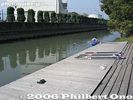
Club's boat dock. This narrow canal leads to Lake Biwa.
|
|
|
|

Azaleas in full bloom along the lake edge
|
|

The boats are wooden, and a few decades old.
|
|
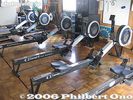
Rowing exercise machines called "ergometers" or "ergo" or "indoor rower." In Japan, they call it "ergo." エルゴThe machine measures the energy you expend rowing. Also measures how fast and far you rowed if you were on water. They even have ergo rowing contests which is a sport itself.
|
|

Patch up
|
|
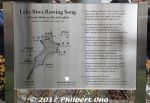
Monument's English side has a bilingual Lake Biwa map and Lake Biwa Rowing Song English lyrics.Directions: From JR Kyoto Station's Karasuma side (north side with Kyoto Tower), go to bus stop D2 and catch the No. 206 bus bound for "Gion Via Kiyomizu-dera Temple/Kitaoji Station" (三十三間堂・清水寺・祇園・百万遍). The bus leaves every 15 min. or so (bus schedule here), but it can be very crowded. The ride takes abut 30 min. Get off at "Kyodai Seimon-mae" (京大正門前). Cross the big road (Higashi-Oji-dori) and walk along Higashi-Ichijo street. The main Yoshida Campus will be on the left while the Yoshida-Minami Campus will be on the right. Enter the Yoshida-Minami Campus and walk to the central courtyard area.
(From Kyoto Station, there is also an express bus (京大快速) to Kyoto University Hospital from bus stop D3, but it runs only at certain times on weekdays, mainly in the morning and mid-afternoon (bus schedule here).
|
|
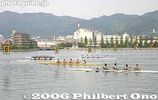
Four-man boat race. There were also foreign rowers from international schools.
|
|

Notice the rudder. Controlled by a pair of strings held by the cox.
|
|
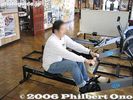
The rowing lesson starts with an ergo workout.
|
|
|

Cheering section for Nagahama
|
|

Beachgoers frolick in the lake as the rowing boats arrive.
|
|

Carrying the boat.
|
|

Moving the kite to launch point
|
|

About the song and rowing route... この歌について(日本語解説)Shiga Prefecture's most famous and beloved song is called Biwako Shuko no Uta (琵琶湖周航の歌) or "Lake Biwa Rowing Song." I have rendered this song into both pictures and English, according to my own imagination and interpretation.
Please see this page for a full explanation: https://photoguide.jp/txt/Lake_Biwa_Rowing_Song
First composed in 1917 by a bunch of college students from Kyoto, the song has been recorded by many famous Japanese singers and groups. In 1971, it became a major nationwide hit with singer Tokiko Kato's rendition. Today, the song remains a favorite among choir groups in Japan, and a choir singing contest is held for the song every June (since 1997) in Imazu, the birthplace of the song in the northwestern corner of Lake Biwa.
Shiga Prefecture also has stone monuments dedicated to each of the six verses. There's even a museum (Biwako Shuko no Uta Shiryokan) in Imazu dedicated to the song. Okaya city on the shores of Lake Suwa in Nagano Prefecture, the birthplace of the song's composer, Taro Oguchi (小口太郎) (1897-1924), also has a song monument and bronze statue of him.
|
|
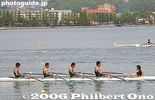
Four-man race with the cox at the stern
|
|

Verse 1 Song Monument, Otsu (Mihogasaki). In 1973, this was the first monument built for the song. The song's first and most famous line, "Ware wa Umi no Ko" is written. 一番の歌碑。大津市三保ケ崎。This monument is near the boat house in Mihogasaki, a stone's throw from Hama-Otsu.
われは湖の子 さすらいの
旅にしあれば しみじみと
のぼる狭霧や さざなみの
志賀の都よ いざさらば
Ware wa Umi no Ko, sasurai no
tabi ni shiareba, shimijimi to
Noboru sagiri ya, sazanami no
Shiga no Miyako yo, iza saraba
|
|

On June 16, 2007, Imazu marked the 90th anniversary of the song by organizing a boat cruise on Lake Biwa and other events. Omi-Imazu Station had a sign directing guests to Imazu Port. 90周年の記念「琵琶湖周航クルーズ」の近江今津駅内
|
|

The orange boat. On the left at the ear is the cox, the middle are four rowers, and at the front of the boat is one extra person who can rest and enjoy the ride.
|
|

During July-Aug. 2007, I helped to make the Yokaichi giant kite at the annex of the Yokaichi Giant Kite Museum.where the giant kite is made. Every three years, the giant kite, flown every May in Higashi-Omi, is replaced by a new kite bearing a new design.The new kite was made during July-Aug. 2007, taking about 30 days. The kite is made by volunteers from the public under the instruction of the Yokaichi Giant Kite Preservation Society. For the first time, I helped make this giant kite which was first flown successsfully on May 25, 2008 at the annual kite festival.
|
|
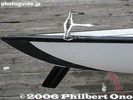
Sleek rudder and steering cables
|
|

Canora Hall, venue for the Okaya International Exchange Association's 15th anniversary festival.
|
|

Front of Yoshida Chiaki's home in Niigata (formerly Niitsu) which I visited in Nov. 2007. Yoshida Chiaki composed a song called "Hitsuji-gusa" (Water Lilies) whose melody was used for the song "Biwako Shuko no Uta" (Lake Biwa Rowi
|
|

Festival siteThey did not allow people go enter the launch area at all times. Spectators were kept far away.
|
|

Starting line. The man says "Yoi" (Ready) then "Go."「用意」、次いで「ゴー」
|
|

Imazu Port. A large crowd of people waiting to board the chartered boat for a 3-hour cruise on Lake Biwa to commemorate the 90th anniversary of the song, Biwako Shuko no Uta.
|
|

Most people were oblivious to the boats.
|
|

Entrance to the annex and a sign indicating the day's event or work. Today, July 7, 2007, was the Noritsuke Pasting Ceremony. 八日市大凧まつり のりつけ式
|
|
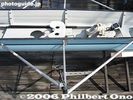
Rowing seat with moving seat on rails, fixed shoes, and outrigger for the oar.
|
|
|
|
|
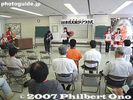
July 7, 2007: The making of the giant kite started with Noritsuke Pasting Ceremony where the new design was announced and dignitaries pasted together the first pieces of the kite paper.
|
|
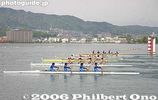
Four-man race starts with the cox at the front.
|
|

The photo above shows part of the stone monument for the first verse of the song. It reads "Ware wa Umi no Ko" (We're children of the lake). [url=http://photoguide.jp/txt/Lake_Biwa_Rowing_Song]More info about Lake Biwa Rowing Song here.[/uThis is the song's first and most famous line. The monument is in a small park near the former boathouse in Mihogasaki pier. The photo has been digitally altered (the colors are not real).
I visited and photographed all the places mentioned in the song as well as all the song monuments in Otsu, Omi-Maiko, Imazu, Chikubushima, Hikone, Chomeiji, and Okaya (Nagano). I also created some digital images to match the scenes mentioned in the song.
|
|

The "Rio Grande" cruise boat awaits at Imazu Port on a miraculously sunny day during the rainy season. 梅雨でありながら、奇跡的にこんないい天気になった。今津港
|
|

Carrying the boat to water.
|
|

Front gate of Yoshida Chiaki's home
|
|

No people on the sides either
|
|

Off they go
|
|

Reception desk for passengers. A little over 100 people joined the cruise. クルーズの受付
|
|

The orange boat decided to go ashore where it was less crowded.
|
|

Before announcing the final kite design, they announced the three best (but not winning) design entries. The public was invited to submit kite designs based on the theme of "Life" or inochi.
|
|
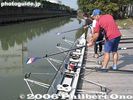
Inserting the oars into the outriggers.
|
|

Inner garden. I met Yoshida Yuki (吉田ゆき), the niece of Yoshida Chiaki who showed me the house and a few materials. Flowers planted by Chiaki still grow in the garden.
|
|

Launch point on a low hill
|
|
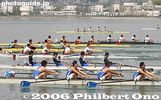
Close-up of rowers at Asahi Regatta
|
|

"Umi no Ko" (Child of the Lake) Lake Biwa training boatThe bow of Shiga Prefecture's "floating school." The name of this boat was obviously taken from the song. The boat is owned by Shiga Prefecture and used to educate elementary school kids about the lake. Since 1983, this ship has been serving as a floating school for kids where they stay overnight and spend two days conducting experiments to learn more about the lake. Picture was taken at Hikone Port.
|
|

Back of Verse 1 Song Monument, Otsu (Mihogasaki)Directions: From JR Otsu Station, take a bus to Mihogasaki. It's about 10 min. Or you can easily walk it from Hama-Otsu Station. Just walk on the main road toward the race boat arena. There will be a small marina on the right. Right after passing the marina, turn right into the small road. There will be a small park on the right. The monument is there. There are two stone monuments. It might be roped off and you're not supposed to enter the park. While you're there, walk around the marina and see the boathouse with the cherry blossom logo with three stripes. That's the logo of the school and the place where the boys left for the rowing trip in 1917. Otsu Station also has a tourist information office where you can obtain directions and a map.
|
|

Boarding time at Imazu Port. In the forefront is a song monument for Biwako Shuko no Uta.
|
|

Two boats will lie here overnight.
|
|

Twenty-six design entries were submitted this year. There was no top winner, so the final design was based on the three best designs. This design features the kanji "Yorokobu" or joyfulness. 今回のテーマは「いのち」
|
|
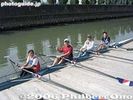
Ready to row on a "quad" sculling race boat. Each person rows with two oars.Sorry for the small image.
|
|

Yoshida Chiaki's room on the 2nd floor.
|
|
|

Cheering section
|
|

Megan and Jamie Thompson about to board the boat. トンプソン姉妹
|
|

Dark Blue Blades, symbol of the Kyoto Univ. rowing club.
|
|

They introduced the three best designs. 最優秀作品はなく、3点の優秀賞作品を参考に保存会が決めた。
|
|
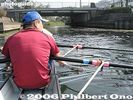
We now enter Lake Biwa.
|
|

Yoshida Chiaki's room on the 2nd floor. This is where he spent his final days while stricken with tuberculosis.
|
|
|
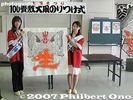
The new kite design was then announced. Called Han-jimon (判じもん), the design expresses a certain theme using word play with a pair of animals and one or two kanji characters. 八日市大凧は3年に一度図柄を変える。
|
|

High school spectators near the finish line
|
|

"Umi no Ko" (Child of the Lake) Lake Biwa training boat for kids
|
|

Near the Verse 1 Song Monument is another stone monument engraved with the words of the entire song.
|
|

Boat name "Rio Grande" operated by Biwako Kisen. Named after Shiga's sister state in Brazil. There is also the "Michigan" paddlewheel boat named after Shiga's sister state in the USA.
|
|

Oars and boats
|
|
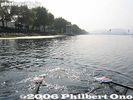
Lake Biwa Rowing Course operated by Shiga Prefecture for major rowing regattas. It is near the head of Seta River, and very near Seta Rowing Club.
|
|

Lake Biwa Rowing Song (Biwako Shuko no Uta) exhibition panel by Philbert Ono at Okaya, Nagano.
|
|

View from Yoshida Chiaki's room on the 2nd floor. Sometimes they receive local school children for tours of the house.
|
|
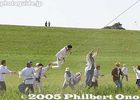
Ride'em cowboyAs the kite quickly flew up, the forward kite pullers had to release the rope.
|
|

The top kanji is "yorokobu" (joyfulness) which can also be read as "ki." The pair of hawks 鷹 can be read as "yo." And the bottom kanji is "sei" (living). It's "Kyosei."
|
|

Kyoto University's cheering section for the 8-man raceComplete with cheerleaders.
|
|

Inside the front of the Rio Grande boat. 琵琶湖周航クルージング
|
|

Day 3: Arrival at Manohama beach, near the west end of Biwako Ohashi Bridge. 真野浜上陸
|
|
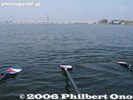
Oars keep the unstable boat stable.
|
|

Lake Biwa Rowing Song Exhibition panels. 「琵琶湖周航の歌」英語版の展示コーナー
|
|

Stairs from Yoshida Chiaki's room on the 2nd floor.
|
|
|
|

Eight-man race
|
|

Small park where the Verse 1 monument is located.This monument is near the boat house in Mihogasaki, a stone's throw from Hama-Otsu. It was built in 1973 as the first monument for the song.
This little park is actually off-limits and you're not supposed to enter it, for some reason. On the left side of the picture is another stone monument hidden by brush. It is engraved with the entire song. In the background, you can see the roof of the boathouse.
|
|

Open deck at the rear. The boat departed at about 11:30 am.
|
|

Manohama is where they change boat crews. Half of the people ride on bicycles on shore, while the other half row on 3 boats.
|
|

Higashi-Omi mayor Nakamura Koichi explains the design. "Kyosei" 共生 means to co-exist (i.e. man and nature) or to live together harmoniously. 中村功一市長
|
|
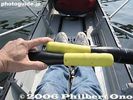
The oar handles overlap when you pull them. Often my hands bumped into each other.
|
|

Original copy of the magazine "Ongaku-kai" (The Musical Japan) where Yoshida Chiaki's song "Hitsuji-gusa" was first published and made popular. Issued in Aug. 1915. 音楽界
|
|
|
|
|

We passed by various scenic spots such as Shirahige Shrine, noted for the torii gate in the lake.
|
|

Landed in fishing lines.
|
|

The mayor and one of the kite design artists wear a sash and pose for a picture before proceeding with the Noritsuke Ceremony.
|
|
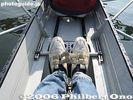
Shoes are fixed to a small, angled platform.
|
|

Table of Contents of magazine "Ongaku-kai" (The Musical Japan) 音楽界. Many music-related articles.
|
|
|

Water intake for Lake Biwa Canal No. 2. Near Mihogasaki in Otsu, and adjacent to the boat racing arena.
|
|

Kyoto Univ. comes in 3rd place
|
|

Shirahige Shrine 白髭神社
|
|

Departing Manohama at about 11:30 am. 真野浜出発
|
|

They used a wide brush to apply paste to the edges of a piece of kite paper.
|
|

On the first page is Yoshida Chiaki's song "Hitsuji-gusa" (Water Lilies) which was acclaimed enough to be published here.
|
|

Michi no EkiThe kite design is the same every year, but the kanji characters change. They make a new giant kite every year.
|
|
|

Misty Horikiri Port in Omi-Hachiman. Boats leave here for Okishima island, Lake Biwa's largest island.
|
|
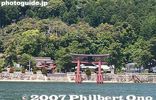
Shirahige Shrine torii as seen from the cruise boat.
|
|

Small motorboat which accompanies the three rowing boats. I was aboard this motorboat and took pictures.
|
|

They joined two sheets of kite paper together. This marked the first step in making the kite. The finished kite paper will consist of a few hundred washi paper sheets pasted together.
|
|
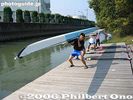
After a neat rowing trip, the boat is lifted out of the water.
|
|

On the first page is Yoshida Chiaki's song "Hitsuji-gusa" (Water Lilies). Although the melody is different, the lyrics are a direct translation of a childen's song called Water Lilies written by E.R.B. in the UK.
|
|
|
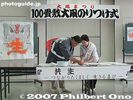
More dignitaries paste the sheets of kite paper together.
|
|

Starting line staff
|
|

Omi-Maiko with green pines on white sands. 近江舞子の「松は緑に 砂白き」
|
|

Biwako Ohashi Bridge 琵琶湖大橋
|
|

Rinsing the shell with fresh water.
|
|

Small book titled "A Garland of Flower-Poems" published in Japan. This was owned by Yoshida Chiaki and it includes the UK song "Water Lilies."
|
|
|
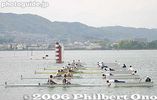
Starting line
|
|

Boat for Okinoshima at Horikiri Port
|
|

Omi-Maiko appears in the song.
|
|

Ferris wheel from the Biwako Tower amusement park, now defunct. 琵琶湖タワー(廃墟)
|
|

The pasted pieces are laid to dry.
|
|

The boat is pencil-thin.
|
|

Page where "Water Lilies" is printed in the book. It is very likely that Chiaki found the song in this book, and decided to make his Japanese version. His signature is on the back of the book.
|
|
|

Waving the signal flag at a checkpoint to staff on shore.
|
|
|

Rolling with the waves
|
|

We were then invited to sign our names on the kite paper.
|
|

Rinsing the oars.
|
|
|
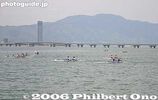
Two-man boat race
|
|
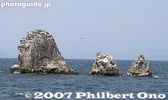
Okino-shiraishi Rocks, a favorite resting place for birds which turned the rocks white from bird droppings. Four rocks stand 80 meters deep in the lake. Out of the water, the tallest stands 14 meters high. 沖の白石
|
|

South of Biwako Ohashi Bridge.
|
|

The kite design announcement and pasting ceremony lasted an hour, after which a group photo was taken.
|
|
|
|

Smaller kite "Yujo"
|
|

Cheering/coaching from bicycle
|
|

So what does "Coral shrine" mean in the song? (There's no coral in the lake.) "I think it just refers to a beautiful place..." 「珊瑚の宮」はどういう意味?
|
|

Rowing past the Ukimido Floating Temple in Katata. 堅田 浮御堂(近江八景)
|
|
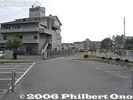
Entrance and road to the rowing clubhouse
|
|
|

Cheering/coaching on foot
|
|

We landed on Chikubushima for about an hour. Jamie and Megan also sang in English in front of the Verse 4 song monument.
|
|

Ukimido Floating Temple, one of the Eight Views of Omi (Omi Hakkei). 堅田 浮御堂(近江八景)
|
|
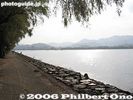
Near the rowing club is the Lake Biwa Rowing Course where regattas are held. 滋賀県立琵琶湖漕艇場
|
|

In Okaya, Nagano, Nakamura Naoko singing "Lake Biwa Rowing Song." This is the first time this English version was sung in public outside Shiga Prefecture.
|
|
|
|
|

Jamie and Megan Thompson sing in English in front of the Verse 4 song monument, Chikubushima. Next time we need to have an amplifier.
|
|

Mt. Hiei 比叡山
|
|

Nakamura Naoko singing "Lake Biwa Rowing Song." The first Japanese person to sing the song in public. 「琵琶湖周航の歌」の英語版も歌われた。
|
|

"Yujo"This is a smaller kite. It means "Friendship."
|
|

Awards ceremony
|
|

Jamie and Megan Thompson sing in English in front of the Verse 4 song monument, Chikubushima. They sang up to Verse 4. ジェイミーとメゲン・トンプソン姉妹が歌う
|
|

Omi-Fuji (Mt. Mikami) and Karasuma Peninsula. 近江富士(三上山)と烏丸半島
|
|

Nakamura Naoko singing "Lake Biwa Rowing Song" up to verse 3. 中村直子さんが三番まで歌われた。
|
|
|
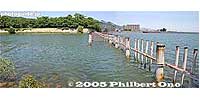
Water intake for Lake Biwa Canal No. 2. The Lake Biwa Canal (Biwako Sosui) supplies water from Lake Biwa in Otsu to Kyoto. After four years of monumental construction, the canal was completed in 1890.
|
|
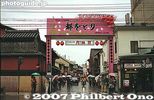
Entrance to the road leading to the Cherry Dance theater (Gion Kobu Kaburenjo) in the Gion district. The sign says "Miyako Odori."
|
|

Verse 2 Song Monument, Omi-Maiko (Omatsu). On the lake shore in Omi-Maiko (Omatsu) behind Hotel Biwa Lake Otsuka. Built in March 1989. 二番の歌碑。近江舞子(ホテル琵琶レイクオーツカの前)Pine trees are very green, on sands very white.
Omatsugasato is, a young maiden's home.
Bush of red camellia, hides her teary face.
She's weeping o'er a lost love, much too short to last.
Matsu wa midori ni, suna shiroki
Omatsugasato no, otomego wa
Akai tsubaki no, morikage ni
Hakanai koi ni, naku toka ya
松は緑に 砂白き
雄松が里の 乙女子は
赤い椿の 森蔭に
|
|

YouTube video of the song Hitsuji-gusa (Water Lilies) by a choir called Koai Gassho no Kai (小合合唱の会) performing at a memorial gathering on the anniversary of Chiaki’s death in Feb. 2013 at Chiaki’s birth home.Video uploaded by Ichii Yasuzo in Niigata.
|
|

Boat landing
|
|

Mihogasaki harbor, Otsu. The arrow points to the boat house where Oguchi Taro and crew departed for their rowing trips.Mihogasaki is accessible by bus from Otsu Station. Or just walk west from Hama-Otsu. This is also where water from the lake is drawn into the Biwako Canal's first canal which feeds water to Kyoto.
|
|

Old photo of Verse 2 Song Monument in Omi-Maiko. The tree was cut down and lyrics later painted white.
|
|

The man holds the 90th Anniversary tour sign as a guide for the tour guests.
|
|

July 8, 2007: On the day after the pasting ceremony, the Kamitsugi or paper joining was next. 紙継ぎ
|
|

She is the cox sitting at the rear and controlling the rudder with a pair of strings. コックス
|
|
|

More signposts reading "Miyako Odori." "Miyako" means capital (Kyoto was once Japan's capital city), and "Odori" means dance.
|
|
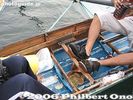
Lots of putty line the seams.
|
|
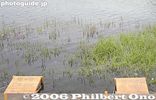
Temporary boat landing
|
|

Getting back on the boat. Little over a hundred people came on this cruise. If people knew it was gonna be such a beautiful day during this rainy season, more would have certainly come.
|
|

Starting at 9:30 am, members of the giant kite preservation society began pasting and joining about 400 sheets of washi paper to make the giant kite paper.
|
|
|

Verse 2 monument is on the lake shore, in front of Hotel Biwa Lake Otsuka, near what appears to be a boat pier. Short walk from Omi-Maiko Station.Directions: Near Omi-Maiko Station on the JR Kosei Line. After exiting the station, walk left toward Kitahama. Then get to the lake shore and walk along the lakeshore road until you see the monument under a large tree right on the shore. It is in front of Hotel Biwa Lake Otsuka.
|
|

"Miyako Odori" sign post. Performed for over a century, the dance makes April a very special time in Kyoto. It helps to hone the dance and musical skills of the geiko and maiko who diligently practice for this annual dance.
|
|

Carrying the boat back
|
|

Entering Okinoshima Port. Okishima is the largest island in Lake Biwa. MAP
|
|

Mihogasaki harbor, Otsu. The arrow points to the boat house.
|
|

Sachiko Tsuji, the MC, interviews the sisters before they sang on the boat. 自動販売機前でインタービュー。船内の客は姉妹の顔や姿がほとんど見えへん。
|
|

The top two rows of washi sheets already pasted together.
|
|

Torii on shore (Hiyoshi Taisha Shrine) near Sakamoto. 鳥居
|
|
|
|

Jamie and Megan Thompson sing in English while cruising on Lake Biwa. 船の真ん中で歌って自動販売機がバックになって最悪。客に背中を向くばかりで申し訳ない。船の一番前に歌いたいと頼んだけど...
|
|

The size of the room almost exactly matches the size of the giant kite which is 12 meters by 13 meters or 100 tatami mats.
|
|

Otsu Prince Hotel in the distance.
|
|

"Miyako Odori" poster in English.
|
|
|

Across the road from the Verse 2 song monument is this small music box. Press the button and you can hear the song play (sung by Kato Tokiko).
|
|

"Miyako Odori" poster and paper lantern.
|
|

Side of boat
|
|

Boat house where Taro Oguchi and crew departed on their rowing trip. No longer used by the university's boat club. Mihogasaki, Otsu
|
|

After they sang, there was a mad rush to buy the CD priced at 800 yen. 英語版CDの購入者が殺到。
|
|

The paper is Mino Washi, from Gifu Prefecture. It is white, and surprisingly thin. I thought it would be thicker. Six or so sheets are stacked while slightly spread apart.
|
|

Cooling off
|
|

She fell
|
|
|

Then they signed autographs on the CD. CDのサインを求める。
|
|

The stacked paper is put on a table where water-based paste is applied to one horizontal and one vertical paper edge.
|
|

Karasaki Pine Tree (One of the Eight Views of Omi or Omi Hakkei) as seen from Lake Biwa. 唐崎の松(近江八景)
|
|

Patch up
|
|

PR posters and paper lanterns for the Miyako Odori are everywhere.
|
|
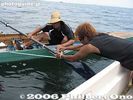
Making repairs. The boats are decades old.
|
|

Verse 1 Lyrics (Otsu) 一番の英訳(大津). School logo on boat house, a cherry blossom with three stripes for Dai-san Koto Gakko.We're children of the lake, off to wander 'round.
This journey fills my heart with, intense happiness.
Rising mist evaporates, ripples come and go.
Shiga's Miyako dear, bid farewell for now.
われは湖の子 さすらいの
旅にしあれば しみじみと
のぼる狭霧や さざなみの
志賀の都よ いざさらば
Ware wa Umi no Ko, sasurai no
tabi ni shiareba, shimijimi to
Noboru sagiri ya, sazanami no
Shiga no Miyako yo, iza saraba
--
This first verse refers to the start of the journey of life. The lake mist symbolizes the uncertainty of what lies ahead.
The capital of Shiga is Otsu, where they departed from Mihogasaki boat harbor on June 27, 1917. For some reason, the kanji characters for "Shiga" is incorrect for Shiga Prefecture.
|
|

More autographs. 姉妹はやはり人気者。
|
|

Each person holds one edge-pasted sheet and line up to align and join the sheet. Each sheet measures about 90 cm by 60 cm. There are also half-size sheets.
|
|
|
|

Ichiriki, a famous geisha tea house.
|
|

Okishima Port
|
|
|

Anybody can help do this. The public is invited to sign their names on a sheet and paste it to the big kite paper.
|
|

Mixing with sailboats.
|
|
|

Maiko and geisha can often be seen in Gion.
|
|

"Rising mist evaporates, ripples come and go." のぼる狭霧や さざなみの
|
|

Water lilies. The melody of the song originally came from a song called "Hitsuji-gusa" which means water lilies.
|
|

The sheets are joined in the same pattern as a brick wall. Every other row of sheets has a half sheet along the edge. Notice the autographs of people on the paper.
|
|
|

"Nakama"This is another smaller kite. It means "Circle of Friends."
|
|

Gate to Kobu Kaburenjo Theater. Four shows daily in April, lasting about 1 hour (too short). Ticket prices range from 1900 yen to 4300 yen.
|
|

Water lily (Hitsuji-gusa). ひつじぐさ
|
|

So the giant kite is actually made of many smaller sheets of paper joined together. Notice my "philbert" autograph on the bottom.
|
|

Near miss?
|
|

Anchor truck
|
|

Water intake for Lake Biwa Canal No. 2
|
|

Gate to Kobu Kaburenjo Theater. You can make ticket reservations by phone, or go directly to the theater ticket office and buy tickets.
|
|
| 2529 files on 11 page(s) |
1 |
 |
 |
 |
 |
|